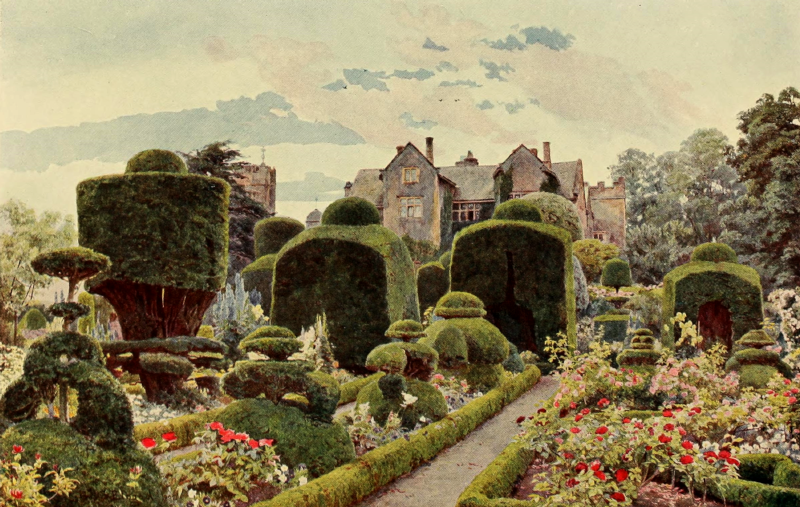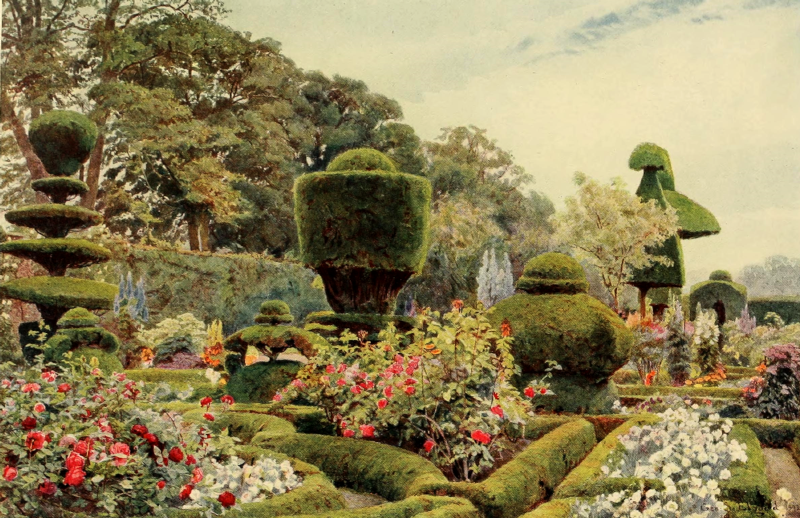| Web
and Book design,
Copyright, Kellscraft Studio 1999-2021 (Return to Web Text-ures) |
 (HOME)
|
|
LEVENS
 LEVENS from the picture in the possession of Major Longfield There
is perhaps no garden in England that has been so often described or so much
discussed as that at Levens in Westmorland, the home of Captain Jocelyn Bagot. It
was laid out near the beginning of the eighteenth century by a French gardener
named Beaumont. There is nothing about it of the French manner, as we know it,
for it is more in the Dutch style of the time, and has become in appearance
completely English; according perfectly with the beautiful old house, and
growing with it into a complete harmony of mellow age, whose sentiment is one
of perfect unison both within and without. Forward
of the house-front, in a space divided by intersecting paths into six main
compartments, is the garden. Flower-borders, box-edged on both sides, form
bordering ornaments all round these divisions. The inner spaces are of turf. At
the angles and at equal points along the borders are strange figures cut in yew
and box. Some are like turned chessmen; some might be taken for adaptations of
human figures, for one can trace a hat-covered head — one of them wears a crown
— shoulders and arms and a spreading petticoat. Some of the yews, and these
mostly in the more open spaces of grass or walk, rise four-square as solid
blocks, with rounded roof and stemless mushroom finial. These have for the most
part arched recesses, forming arbours. One of the tallest, standing clear on
its little green, is differently shaped, being round in plan above and the
stems bared all round below, with an encircling seat. No
doubt many of the yews have taken forms other than those that were originally
designed; the variety of shape would be otherwise too daring; but these
recklessly defiant escapes from rule only add to the charm of the place,
presenting a fresh surprise at every turn. The play of light and variety of
colour of the green surfaces of the clipped evergreens is a delight to the
trained colour-eye. Sometimes in shadow, cold, almost blue, reflecting the sky,
with a sunlit edge of surprising brilliancy of golden-green — often all bright
gold-green when the young shoots are coming, or when the sunlight catches the
surface in one of its many wonderful ways. For the trees, clipped in so many
diversities of form, offer numberless planes and facets and angles to the
light, whose play upon them is infinitely varied. Then the beholder, passing on
and looking back, sees the whole thing coloured and lighted anew. This quantity
of Yew and Box clipped into an endless variety of fantastic forms has often
been criticised as childish. Would that all gardens were childish in so happy a
way! Is not the joy and perfectly innocent delight that the true lover of
flowers feels in a good garden in itself akin to childishness, and is not a
fine old English garden such as this, with its numberless incidents that stir
and gratify the imagination, and its abundance of sweet and beautiful flowers,
just the one that can give that happiness in the greatest degree f Does not the
oldest of our legends, so closely bound up with our youngest apprehension of
religious teaching, tell us of the earliest of our race of whom we have any
record or even tradition, living happily in a garden in a state of childish
innocence? Why should a garden not be childish? — perhaps when it truly
deserves such a term it is the highest praise it could possibly have! However
this may be the fact remains that those who own this garden of many wonders,
and watch and tend it with unceasing love and reverence, and others who have
had the happiness of working in it for many days together, find it a place that
never wearies, but only continues day by day to disclose new beauties and new
delights. Doubtless it is a garden that cannot be fairly judged from a hasty
glance or a few hours' visit. Like many of the places and things that we call
inanimate — though to one who knows and loves a garden nothing is more vitally living
— such a place has its moods and can frown upon an unsympathetic beholder.  LEVENS:
ROSES AND PINKS The garden is filled with many Roses and well-grown
hardy plants; those especially of tall stature making a fine
effect. The Rose garden has White Pinks in its outer beds. Immediately beyond
the garden's bounds is wild ground of a beautiful character. The river Kent, a rock-strewn
stream with steep wooded banks, flows within fifty yards of the house. The
contrast is a great and a delightful one. Wild parkland and untamed river
without; and within the walls ordered restraint; then again, the quiet of the
wide bowling-green, with its dark clipped hedges, and beyond it a long,
tree-shaded walk. Precious,
indeed, are the few remaining gardens that have anything of the character of
this wonderful one of Levens; gardens that above all others show somewhat of
the actual feeling and temperament of our ancestors. They show personal
discrimination combining happily with common-sense needs; walls and masses of
yew and box to make shelter from the violence of wind, and yet to admit the
welcome sunlight; so to provide the best conditions in the inner spaces for the
growing of lovely flowers. Then the shaping of some of the yews into strange forms,
shows perhaps the whimsical humour of some one of a line of owners, preserved,
with careful painstaking, by his descendants. A garden
many generations old may thus be a reflection of the minds of several of such
possessors — men who have not only thankfully paced its green spaces and
delighted in its flowery joys, but who have held it in that close and friendly
fellowship whose outcome is sure to be some living and lasting addition either
to its comfort, its interest, or its beauty. The original design may have
become in some degree lost, but unless the doings of the several owners have
been in the way of destruction or radical alteration, or something of obvious
folly or bad taste, the garden will have gained in a remarkable degree that quality
of human interest that is not easy to define but that is clearly perceptible,
not only to a trained critic but to any one who has knowledge of its most vital
needs and sympathy with its worthiest expression. This precious utterance is
not confined to this or to any one special kind of gardening, but may pervade
and illuminate almost any one of the many ways in which men find their pleasure
and delight in ordering the sheltered seclusion of their home grounds, and
enjoying the varied beauty of tree and bush and flower. It is
only in gardens of the most rigidly formal type, such as are full of
architectural form and detail and admit of no alteration of the original plan,
that personal influence can least be exercised. This is no doubt the reason why
such gardens, correctly beautiful though they may be, are those that give in
smallest measure that wonderful sense of the purest and most innocent happiness,
that of all earthly enjoyments seems to be the most directly God-given. Yet, even in such gardens, it is not impossible that some impress of the personal influence may be beneficently given, but the range of operation is extremely limited, the greatest knowledge and ability are needed, with the sure action of the keenest and most restrained judgment.
|